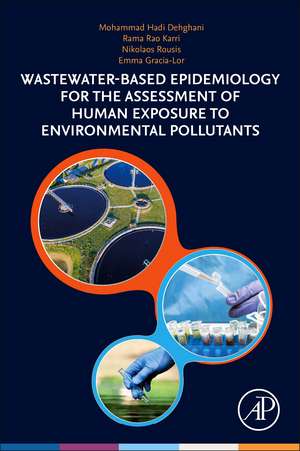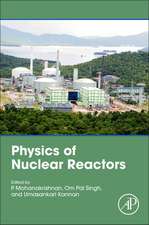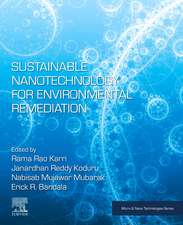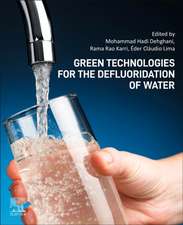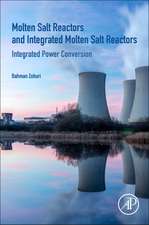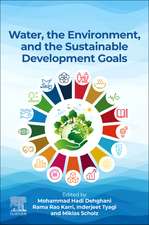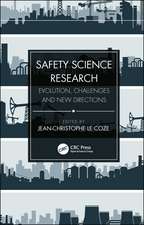Wastewater-Based Epidemiology for the Assessment of Human Exposure to Environmental Pollutants
Editat de Mohammad Hadi Dehghani, Rama Rao Karri, Nikolaos Rousis, Emma Gracia-Loren Limba Engleză Paperback – 8 aug 2023
- Presents evidence mapping to identify emerging areas in wastewater-based epidemiology studies
- Offers expansion and diversification strategies in pandemic conditions to serve immediate public health goals
- Explains the surveillance of the spread of pathogens through wastewater
Preț: 886.39 lei
Preț vechi: 1080.96 lei
-18% Nou
Puncte Express: 1330
Preț estimativ în valută:
169.62€ • 175.25$ • 141.10£
169.62€ • 175.25$ • 141.10£
Carte disponibilă
Livrare economică 26 februarie-12 martie
Livrare express 12-18 februarie pentru 31.01 lei
Preluare comenzi: 021 569.72.76
Specificații
ISBN-13: 9780443191725
ISBN-10: 0443191727
Pagini: 284
Dimensiuni: 152 x 229 x 20 mm
Greutate: 0.46 kg
Editura: ELSEVIER SCIENCE
ISBN-10: 0443191727
Pagini: 284
Dimensiuni: 152 x 229 x 20 mm
Greutate: 0.46 kg
Editura: ELSEVIER SCIENCE
Public țintă
Toxicologists, analytical and environmental chemists, environmental scientists, epidemiologists, public health professionals. government policy makers; healthcare professionals in disease controlCuprins
Contributors
About the editors
Preface
Acknowledgments
1. Wastewater-based epidemiology: Evidence mapping toward identifying emerging areas of research
Mina Aghaei, Masud Yunesian, Hosna Janjani and Mohammad Hadi Dehghani
1.1 Introduction
1.2 Material and methods
1.3 Results and discussion
1.4 Challenges and limitations
1.5 Conclusion
Conflict of interest
Acknowledgment
References
2. Moving beyond wastewater analysis toward epidemiology
Cobus Gerber, Emma L. Jaunay, Bradley S. Simpson and Jason M. White
2.1 Introduction
2.2 Drug consumption, metabolism, and excretion
2.3 Wastewater sampling and analysis
2.4 Beyond analysis toward epidemiology
2.5 Conclusions
References
3. Sampling techniques in wastewater-based epidemiology approach
Lilian Feltraco Lizot, Marcos Frank Bastiani, Camila Favretto de Souza, Roberta Zilles Hahn and Rafael Linden
3.1 Introduction
3.2 Active sampling
3.3 Passive sampling
3.4 Conclusion
References
4. Assessment of in-sample and in-sewer stability of biomarkers in wastewater-based epidemiology: an important step
Jianfa Gao, Jake W. O’Brien, Jiaying Li, Phil Choi, Yijing Li and Phong K. Thai
4.1 Introduction
4.2 Methodology used to evaluate biomarker stability
4.3 In-sewer stabilities of biomarkers
4.4 In-sample stability of biomarkers and the selection of preservative methods
4.5 Factors affecting the degradation of biomarkers
4.6 Implications for wastewater-based epidemiology
4.7 Conclusions
Acknowledgement
References
5. Population biomarkers for wastewater-based epidemiology
Jake W. O’Brien, Phong K. Thai and Benjamin J. Tscharke
5.1 Introduction
5.2 Flowdthe first proposed wastewater population biomarker
5.3 What makes a good wastewater-based epidemiology population marker?
5.4 Summary and perspective: continuing the quest for identifying population biomarkers
Acknowledgements
References
6. Wastewater-based epidemiology through pharmaceuticals as biochemical markers and associated challenges
Charu Juneja, Purusottam Tripathy, Om Prakash, Deepak Panchal, Abhishek Sharma, Ritesh Vijay and Sukdeb Pal
6.1 Introduction
6.2 Water fingerprinting through WBE: a new approach to evaluating public health
6.3 Biomarkers of pharmaceuticals and personal care products
6.4 Population biomarker: a paradigm for PPCPs prevalence
6.5 Limitations
6.6 Conclusion
Acknowledgments
References
7. The complexities associated with the detection of new psychoactive substances in wastewater
Richard Bade, Dhayaalini Nadarajan and Cobus Gerber
7.1 Introduction
7.2 Analytical methods
7.3 Considerations for future methods
7.4 Conclusion
References
8. Wastewater-based epidemiology for assessing and monitoring human exposure to pesticides
Evsen Yavuz Guzel, Asli Atasoy Aydin and Nebile Daglioglu
8.1 Introduction
8.2 Pesticides groups
8.3 Analytical method
8.4 Stability of parent pesticides and their metabolites in wastewater
8.5 Human risk assessment
8.6 Limitations and future research needs
8.7 Conclusion
References
9. Expansion and diversification of wastewater-based epidemiology strategies in pandemic conditions to serve immediate public health goals
Erin M. Driver, Devin A. Bowes and Rolf U. Halden
9.1 Introduction
9.2 Materials and methods
9.3 Results and discussion
9.4 Conclusion
References
10. Viral surveillance of wastewater as a promising tool to assess the spread of pathogens in the population: the experience of SARS-CoV-2
Giulia Salmoiraghi, Silvia Schiarea, Laura Pellegrinelli, Valeria Primache, Sandro Binda, Elena Pariani, Giovanni Nattino, Guido Bertolini, Francesca Pizza, Ettore Zuccato and Sara Castiglioni
10.1 Introduction
10.2 Aim of the study
10.3 Material and methods
10.4 Results and discussion
10.5 Conclusion
Acknowledgments
References
Index
About the editors
Preface
Acknowledgments
1. Wastewater-based epidemiology: Evidence mapping toward identifying emerging areas of research
Mina Aghaei, Masud Yunesian, Hosna Janjani and Mohammad Hadi Dehghani
1.1 Introduction
1.2 Material and methods
1.3 Results and discussion
1.4 Challenges and limitations
1.5 Conclusion
Conflict of interest
Acknowledgment
References
2. Moving beyond wastewater analysis toward epidemiology
Cobus Gerber, Emma L. Jaunay, Bradley S. Simpson and Jason M. White
2.1 Introduction
2.2 Drug consumption, metabolism, and excretion
2.3 Wastewater sampling and analysis
2.4 Beyond analysis toward epidemiology
2.5 Conclusions
References
3. Sampling techniques in wastewater-based epidemiology approach
Lilian Feltraco Lizot, Marcos Frank Bastiani, Camila Favretto de Souza, Roberta Zilles Hahn and Rafael Linden
3.1 Introduction
3.2 Active sampling
3.3 Passive sampling
3.4 Conclusion
References
4. Assessment of in-sample and in-sewer stability of biomarkers in wastewater-based epidemiology: an important step
Jianfa Gao, Jake W. O’Brien, Jiaying Li, Phil Choi, Yijing Li and Phong K. Thai
4.1 Introduction
4.2 Methodology used to evaluate biomarker stability
4.3 In-sewer stabilities of biomarkers
4.4 In-sample stability of biomarkers and the selection of preservative methods
4.5 Factors affecting the degradation of biomarkers
4.6 Implications for wastewater-based epidemiology
4.7 Conclusions
Acknowledgement
References
5. Population biomarkers for wastewater-based epidemiology
Jake W. O’Brien, Phong K. Thai and Benjamin J. Tscharke
5.1 Introduction
5.2 Flowdthe first proposed wastewater population biomarker
5.3 What makes a good wastewater-based epidemiology population marker?
5.4 Summary and perspective: continuing the quest for identifying population biomarkers
Acknowledgements
References
6. Wastewater-based epidemiology through pharmaceuticals as biochemical markers and associated challenges
Charu Juneja, Purusottam Tripathy, Om Prakash, Deepak Panchal, Abhishek Sharma, Ritesh Vijay and Sukdeb Pal
6.1 Introduction
6.2 Water fingerprinting through WBE: a new approach to evaluating public health
6.3 Biomarkers of pharmaceuticals and personal care products
6.4 Population biomarker: a paradigm for PPCPs prevalence
6.5 Limitations
6.6 Conclusion
Acknowledgments
References
7. The complexities associated with the detection of new psychoactive substances in wastewater
Richard Bade, Dhayaalini Nadarajan and Cobus Gerber
7.1 Introduction
7.2 Analytical methods
7.3 Considerations for future methods
7.4 Conclusion
References
8. Wastewater-based epidemiology for assessing and monitoring human exposure to pesticides
Evsen Yavuz Guzel, Asli Atasoy Aydin and Nebile Daglioglu
8.1 Introduction
8.2 Pesticides groups
8.3 Analytical method
8.4 Stability of parent pesticides and their metabolites in wastewater
8.5 Human risk assessment
8.6 Limitations and future research needs
8.7 Conclusion
References
9. Expansion and diversification of wastewater-based epidemiology strategies in pandemic conditions to serve immediate public health goals
Erin M. Driver, Devin A. Bowes and Rolf U. Halden
9.1 Introduction
9.2 Materials and methods
9.3 Results and discussion
9.4 Conclusion
References
10. Viral surveillance of wastewater as a promising tool to assess the spread of pathogens in the population: the experience of SARS-CoV-2
Giulia Salmoiraghi, Silvia Schiarea, Laura Pellegrinelli, Valeria Primache, Sandro Binda, Elena Pariani, Giovanni Nattino, Guido Bertolini, Francesca Pizza, Ettore Zuccato and Sara Castiglioni
10.1 Introduction
10.2 Aim of the study
10.3 Material and methods
10.4 Results and discussion
10.5 Conclusion
Acknowledgments
References
Index
